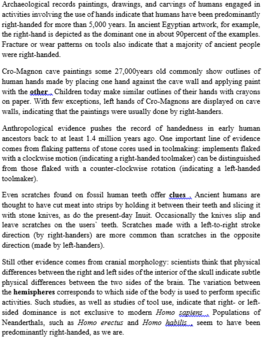Read the following passage and mark the letter A, B, C, or D on your answer sheet to indicate the correct answer to each of the questions from 36 to 42.
Scientists do not yet thoroughly understand just how the body of an individual becomes sensitive to a substance that is harmless or even wholesome for the average person. Milk, wheat, and egg, for example, rank among the most healthful and widely used foods. Yet these foods can cause persons sensitive to them to suffer greatly. At first, the body of the individual is not harmed by coming into contact with the substance. After a varying interval of time, usually longer than a few weeks, the body becomes sensitive to it, and an allergy has begun to develop. Sometimes it’s hard to figure out if you have a food allergy, since it can show up so many different ways. Your symptoms could be caused by many other problems. You may have rashes, hives, joint pains mimicking arthritis, headaches, irritability, or depression. The most common food allergies are to milk, eggs, seafood, wheat, nuts, seeds, chocolate, oranges, and tomatoes. Many of these allergies will not develop if these foods are not fed to an infant until her or his intestines mature at around seven months. Breast milk also tends to be protective. Migraines can be set off by foods containing tyramine, phenathylamine, monosodium glutamate, or sodium nitrate. Common foods which contain these are chocolate, aged cheeses, sour cream, red wine, pickled herring, chicken livers, avocados, ripe bananas, cured meats, many Oriental and prepared foods (read the labels!). Some people have been successful in treating their migraines with supplements of B-vitamins, particularly B6 and niacin. Children who are hyperactive may benefit from eliminating food additives, especially colorings, and foods high in salicylates from their diets
The topic of this passage is______________.
A. reactions to foods
B. food and nutrition
C. infants and allergies
D. a good diet








Đáp án A
A những phản ứng với thức ăn.
B thức ăn và dinh dưỡng
C trẻ em và dị ứng
D một chế độ ăn uống tốt
Giải thích: Câu chủ đề của đoạn là câu đầu tiên “Scientists do not yet thoroughly understand just how the body of an individual becomes sensitive to a substance that is harmless or even wholesome for the average person.” (Các nhà khoa học vẫn chưa hiểu hết được làm cách nào mà cơ thể của một cá nhân lại nhạy cảm với một chất mà vô hại hoặc thậm chí lành cho một người bình thường)
DỊCH BÀI
Các nhà khoa học vẫn chưa hiểu hết được làm cách nào mà cơ thể của một cá nhân lại nhạy cảm với một chất mà vô hại hoặc thậm chí lành cho một người bình thường. Ví dụ, sữa, lúa mì, và trứng được xếp hạng vào nhóm các thực phẩm có lợi cho sức khỏe và được sử dụng rộng rãi nhất. Tuy nhiên, những thực phẩm này có thể gây ra cho những người nhạy cảm với chúng phải chịu thiệt hại rất nhiều. Ban đầu, cơ thể của người đó không bị tổn hại bởi tiếp xúc với các chất. Sau một khoảng thời gian, thường dài hơn một vài tuần, cơ thể trở nên nhạy cảm với nó và dị ứng cũng bắt đầu phát triển. Đôi khi thật khó để phát hiện ra nếu bạn bị dị ứng thức ăn, vì nó có thể xuất hiện với quá nhiều cách khác nhau. Các triệu chứng của bạn có thể bị gây ra bởi nhiều vấn đề khác. Bạn có thể có mẩn đỏ, nổi mề dây, đau khớp dẫn đến viêm khớp, đau đầu, khó chịu, hoặc trầm cảm. Các dị ứng thực phẩm phổ biến nhất là sữa, trứng, hải sản, lúa mì, củ, hạt, sô cô la, cam, và cà chua. Nhiều loại dị ứng sẽ không phát triển nếu những thực phẩm này không được làm thức ăn cho trẻ sơ sinh cho đến khi đường ruột của bé trưởng thành vào khoảng bảy tháng. Sữa mẹ cũng có xu hướng bảo vệ. Chứng đau nửa đầu có thể bị gây ra bởi các loại thực phẩm có chứa tyramine, phenathylamine, bột ngọt, hoặc natri nitrat. Các thực phẩm thường chứa các chat này là sô - cô - la, phô - mai để lâu, kem chua, rượu vang đỏ, cá trích muối, gan gà, quả bơ, chuối chín, loại thịt ướp muối, nhiều loại thức ăn làm sẵn ở phương Đông ( hãy đọc nhãn!) Một số người đã thành công trong việc điều trị chứng đau nửa đầu của họ bằng cách bổ sung các vitamin B, đặc biệt là B6 và niacin. Những trẻ quá hiếu động có thể được hưởng lợi từ việc loại bỏ các chất phụ gia thực phẩm, đặc biệt là chất tạo màu, và các thực phẩm giàu salicylate từ chế độ ăn uống của chúng